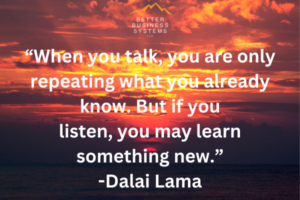In today’s fast-paced workplace, listening can be harder than ever. Less than 2 percent of all professionals have had formal training to improve their listening skills, according to the Harvard Business Review.
Like most, during daily interactions, you’re just waiting for an open space in the conversation so you can steer the discussion where you want it to go. Sound familiar? That’s a surefire way that we can unwittingly shut down effective communications. Here are some other bad habits that make improving communications an uphill battle:
-
Being distracted
-
Interrupting others
-
Dominating the conversation
-
Making the conversation a monologue
-
Needing to be right
-
Giving advice too quickly without listening
-
Formulating a response before the other person is done talking
Unfortunately, when we do these things, we devalue what other people are saying and lose the opportunity to establish rapport, so we can build trust, gain influence and achieve cooperation or collaboration.
Strong listening skills can counteract the tendency for leaders to believe they know everything they need to know about what’s happening in their organizations. Leaders can easily become over-confident, missing important cues that could protect the company from crisis or prevent costly mistakes.
Better yet, leaders can miss ideas that could boost revenue and profits – all because of being too self-absorbed and impatient to take the time to really listen. So why don’t leaders prioritize the skill of deeper listening?
Information Bubbles
As leaders, we can inadvertently trap ourselves in “information bubbles” – where we hear what we want to hear because we haven’t learned to listen well. In effect, we literally become clueless about what’s really going on, without realizing it.
Success Theater
Although leaders have access to more information than most others, it can be compromised. Key facts can be omitted or data can be given a positive spin from team members. These dynamics can lead to the phenomenon called a “success theater,” where employees frame results in ways to avoid tough conversations or suggest that everything is progressing well.
Ivory-Tower Mindset
As a result of the above dynamics, leaders can get stuck in an “ivory-tower mindset,” where the gap between perceptions and the reality of what’s happening will grow. The result is ineffective decision-making – which can limit growth, destroy culture and send top talent exiting for the door. To counteract this tendency, it’s critical for us to create an environment where people feel free to challenge us, so we can better avoid blind spots.
Listening involves far more effort and discipline than most leaders realize. Here are some tips on how to cultivate the discipline of “active listening” from a Harvard Business Review survey of 600 CEOs:
Seek to Understand. The purpose of active listening is to achieve understanding, without distraction or judgment. Active listening shows that our team matters, their insights are valuable and their concerns are valid. It also demonstrates empathy and respect for different perspectives and experiences – ultimately building relationships and trust.
Limit Distractions. It’s nearly impossible to practice active listening if we’re surrounded by distractions. This means closing our laptop, muting our phone and pausing our own agenda so we can focus and engage in the conversation. When we let the world intrude on a conversation, we’re unconsciously telling others that they are less important.
Remain Fully Present. If we’re preoccupied with our own agenda while we’re listening, in effect, we’re formulating a response rather than processing what the other person is saying.
Show Interest Physically. We can use body language to show that we’re listening. Make eye contact, provide a nod to show we’re tracking with them, or smile to affirm them. We might also “mirror” their physical motions, by leaning forward or turning an ear to them.
Show Interest Verbally. Use paraphrasing or verbal mirroring to show we’re tracking with the conversation. Paraphrasing is when we summarize what someone says in our words. For example, “So it seems like what you’re saying is…” or “What I’m hearing here is…” Mirroring is when we summarize the last few words or key phrases in their exact words to demonstrate that we’ve heard them.
W.A.I.T. To avoid the danger of needing to control the conversation or promote our own ideas, simply remember this simple acronym: WAIT, or “Why Am I Talking?”
20/80 Rule. Another rule of thumb is to follow the 20/80 Rule: Talk about 20% and listen about 80% to show we’re truly interested in their perspective.
Be Curious. Avoid asking questions that can be answered with a “yes” or “no.” Open-ended questions invite the other party to share more and create mutual understanding, for example:
-
What do you think about that?
-
How do you see that working?
-
Can you expand on that point?
The Harvard Business Review article, “Are You Really Listening,” suggests creating a “listening ecosystem,” where we actively seek out input through creating “structures,” such as holding regular town hall meetings, Q & A sessions with broader groups of employees, annual employee surveys, or meetings with smaller groups from various departments and ranks. By creating these kinds of structures, we let people know that we want to hear what they have to say. Because we’ve created organizational architecture to support active listening, employees begin to believe that we care about their perspectives.
There’s an old adage that says, “If you don’t know there’s an issue, you’ll eventually have a problem. And if you don’t know there’s a problem, in time you’ll have a crisis.”
The point is to operationalize a way to identify and resolve issues early on – before they become costly to solve in time and expense.
By encouraging employees to feel comfortable sending an email or setting up a meeting to point out something important, we can create an “early warning system” – giving them permission to share bad news or a good idea that could change the company’s future.
But, if we just walk around and see a bunch of smiling faces and say, “Gee, everybody looks happy,” we’re not listening!
Active listeners follow Stephen Covey’s fifth habit in his bestselling book, 7 Habits of Highly Effective People: “It’s critical to seek first to understand, then to be understood.” Seeking real understanding affirms what we all want – to be understood, valued and affirmed.







